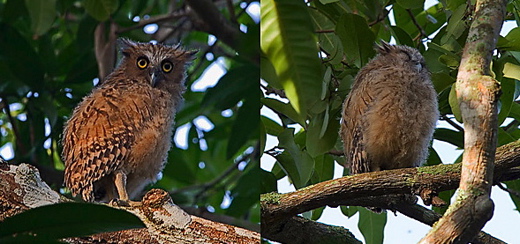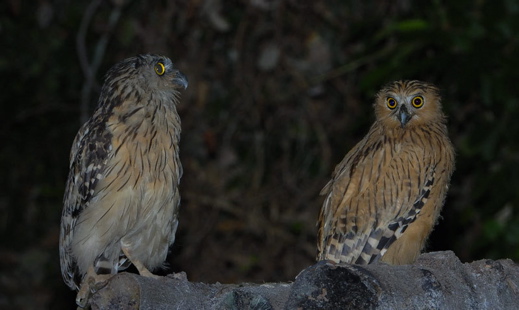“One of the most common owls I have encountered in Singapore is the Buffy Fish Owl (Ketupa ketupu) (left). The owl breeds on the mainland and also on the offshore island of Pulau Ubin.
“I once went to a villager’s house where the breeding seems to be prolific and I interviewed the resident about the owls.
“He said ‘The owl will come to make a nest in a hole in the tree trunk. When the baby owl gets bigger, it will come out and hang around to be fed fish by the parent. When it is exposed, it gets attacked by crows and other birds and will fall to the ground. Sometimes when it begins to learn to fly, it may also fall on the ground’.
“It is not uncommon for people to pick up a helpless baby owl and take care of it until it fledges (below). Interestingly, the villager did pick up fallen baby owls and put them on an elevated wooden platform. The parents would come in the evening and continue feeding the juvenile.
“Some juveniles learn to fly fairly easily while others take a longer time, often falling to the ground. On the ground the young bird is exposed to predators like civet cat, domestic cat, etc.
“When a juvenile owl is approached, it makes a cup-cup-cup sound by clapping its beak. It may also clap in response to threats or when annoyed. While we call this clapping, the sound may actually be caused by the clicking of the tongue, not the bill. The parents will invariably fly down close to observe what is going on (below).
“I once stayed with a baby owl for four hours. It eventually recognised me and will not beak clap. If someone else approached it will clap again. So owls obviously have the ability to recognise people who do not threaten them just like geese used as guard dogs by Chinese farmers.”
Allan Teo
Singapore
30th April 2007












3 Responses
how to distinguish the sex of the buffy fish owl..thanx
good information for my project. Eek! i have to tell anythng and everything about 10 different owls. Due tomarrow, im done for.